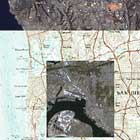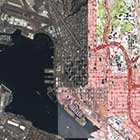Other Case Studies
The SMART partnership supports improved law enforcement and biological monitoring in protected areas around the world. They came to Refractions to build a software tool to help meet their needs.
Hectares BC – Biodiversity BC on behalf of a broad partnership
Biodiversity BC and its government and non-government partners were looking for regional-level environmental statistics. Refractions proposed a new approach to generating GIS summaries, using the power of a relational database and web tools to provide GIS analysis to users who previously had no access to it.
Automated Route Planning for Meter Reading – City of Vancouver
The City of Vancouver collects water readings from thousands of residences and businesses, but has never optimized the pedestrian routes the readers take. Refractions developed algorithms to create the most efficient routes of the correct length for readers.
Digital Road Atlas – BC Integrated Land Management Bureau
Refractions provides full-service support for the British Columbia Digital Roads Atlas – systems design, maintenance, data conflation, client service, and rapid response.
Caribou Habitat Assessment and Supply Estimator – Wildlife Infometrics Inc.
Refractions converted a legacy habitat modelling system based on ArcView 3.X to ArcGIS 9.2, and automated the workflow to provide faster turnaround time for model runs.
Line Cleaner – BC Ministry of Forests
The British Columbia Ministry of Forests needed a tool to conflate multiple roads databases into a single working layer. Refractions delivered the algorithms and a user interface based on the uDig platform.
Interest Reports – BC Ministry of Agriculture & Lands
Refractions developed an ArcMap extension to automate the calculation of standard reports joining a massive shape-file archive with a large Oracle database.
Mobile GIS – UN Food & Agriculture Organization
UN FAO needed a data collection tool that could run disconnected and didn't have a per-seat licensing cost. Refractions delivered a simple tool using the uDig desktop platform.
Open Web Services, Phase 3 – Open Geospatial Consortium
The Open Geospatial Consortium runs regular “testbed” projects to field-test new concepts in geospatial interoperability. Refractions was a part of the OWS-3 initiative, and built a uDig-based “GeoDSS” client to provide access to several other OGC standard services, including a prototype GeoVideo service.
Natural Language Spatial Search Engine for Rental Places-Rento
Rento is a free web service that makes it easy to find a place to rent in Greece. Powered by PostgreSQL and PostGIS, it provides ad listings with photographs displayed on a map. Searching is accomplished through map navigation and natural language processing, with the search engine being capable of answering complex (spatial) questions such as "flat near the University of Athens" or "loft up to 800 euros near a metro station" (in greek).
PostGIS Implementation Advice – SANZ / EarthWhere
Our Client
SANZ Corporation
September 2004
http://www.earthwhere.com/
EarthWhere is now marketed by SPADAC
Project Background

The SANZ corporation is a prominent supplier of imagery management software and systems. Their EarthWhere™ software combines high-performance image processing technology with advanced metadata management and process control – it has been deployed in numerous departments throughout the US government and military.
SANZ uses PostgreSQL/PostGIS as the spatial database back-end for their EarthWhere™ product. During development of a new release of EarthWhere, SANZ found that they were not getting acceptable performance from the database during some load tests.
Refractions' Solution

SANZ hired Refractions for advice on tuning their PostgreSQL/PostGIS database configuration and data model.
- Refractions took a sample of SANZ data and queries, and created a performance profile of the application and query plans.
- Using the performance profile, Refractions re-wrote some of the queries to use indexes more effectively, and suggested changes to the data model itself to speed up queries.
- Refractions also provided advice on default configuration tunings to use when deploying the database on client hardware.
The Result
By implementing Refractions' suggestions, SANZ improved their system performance by a factor of ten for their new release.